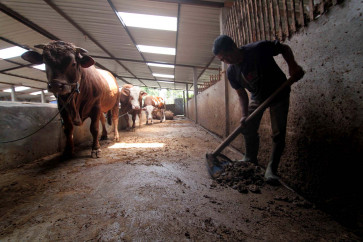Popular Reads
Top Results
Can't find what you're looking for?
View all search resultsPopular Reads
Top Results
Can't find what you're looking for?
View all search resultsCoronavirus found in air samples up to 4 meters from patients
Change text size
Gift Premium Articles
to Anyone
A
new study examining air samples from hospital wards with COVID-19 patients has found the virus can travel up to 13 feet (four meters) -- twice the distance current guidelines say people should leave between themselves in public.
The preliminary results of the investigation by Chinese researchers were published Friday in Emerging Infectious Diseases, a journal of the US Centers for Disease Control and Prevention (CDC).
They add to a growing debate on how the disease is transmitted, with the scientists themselves cautioning that the small quantities of virus they found at this distance are not necessarily infectious.
The researchers, led by a team at the Academy of Military Medical Sciences in Beijing, tested surface and air samples from an intensive care unit and a general COVID-19 ward at Huoshenshan Hospital in Wuhan. They housed a total of 24 patients between February 19 and March 2.
They found that the virus was most heavily concentrated on the floors of the wards, "perhaps because of gravity and air flow causing most virus droplets to float to the ground."
High levels were also found on frequently touched surfaces like computer mice, trashcans, bed rails and door knobs.
"Furthermore, half of the samples from the soles of the ICU medical staff shoes tested positive," the team wrote. "Therefore, the soles of medical staff shoes might function as carriers."
Read also: Social distancing: What it is and why it's the best tool we have to fight the coronavirus
Airborne threat?
The team also looked at so-called aerosol transmission -- when the droplets of the virus are so fine they become suspended and remain airborne for several hours, unlike cough or sneeze droplets that fall to the ground within seconds.
They found that virus-laden aerosols were mainly concentrated near and downstream from patients at up to 13 feet -- though smaller quantities were found upstream, up to eight feet.
Encouragingly, no members of the hospital staff were infected, "indicating that appropriate precautions could effectively prevent infection," the authors wrote.
They also offered advice that bucks orthodox guidelines: "Our findings suggest that home isolation of persons with suspected COVID-19 might not be a good control strategy" given the levels of environmental contamination.
Aerosolization of the coronavirus is a contentious area for scientists who study it, because it is not clear how infectious the disease is in the tiny quantities found in ultrafine mist.
The World Health Organization has so far downplayed the risk.
US health authorities have adopted a more cautious line and urged people to cover their faces when out in public in case the virus can be transmitted through normal breathing and speaking.











